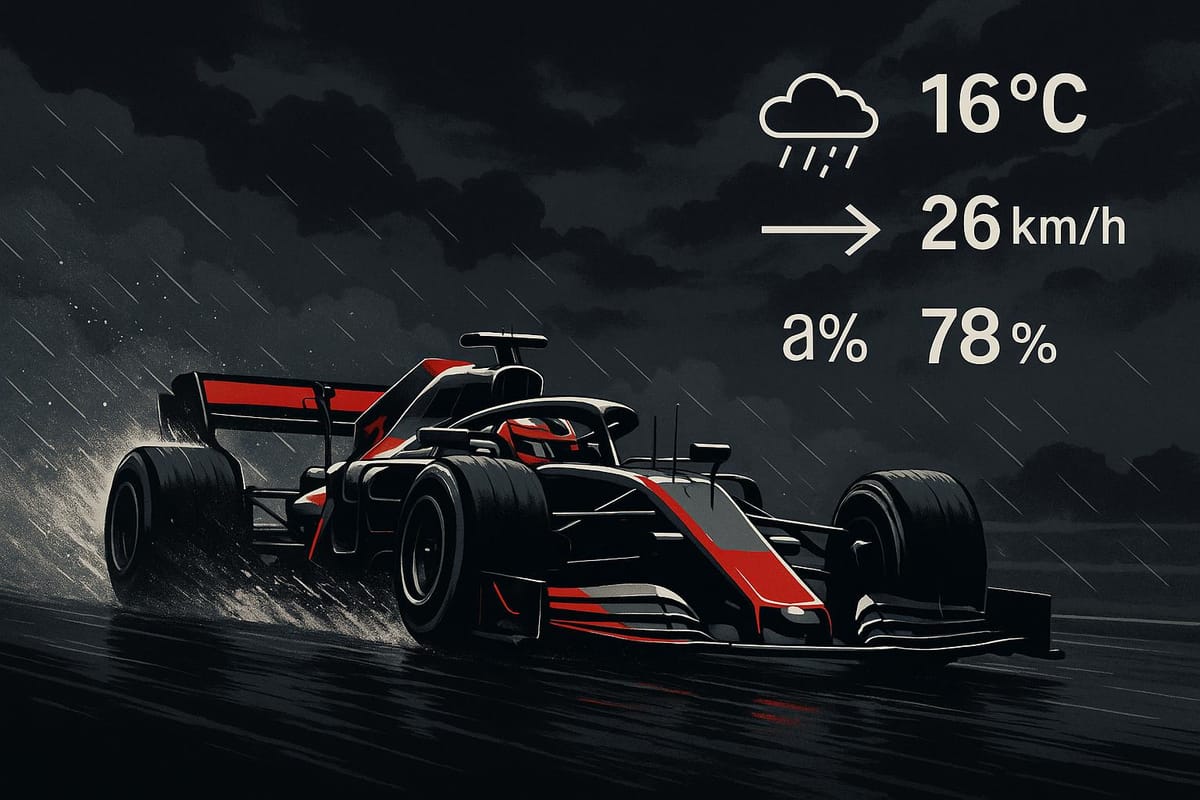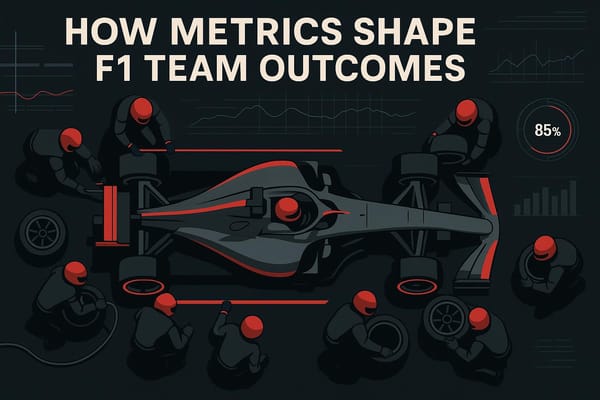How F1 Teams Use Weather Data for Race Strategy
Explore how Formula 1 teams leverage real-time weather data to shape race strategies, enhancing performance and decision-making on the track.

Weather is a game-changer in Formula 1. Teams use real-time weather data to make critical decisions during races, from choosing the right tires to adjusting car setups. Here's a quick breakdown of how weather impacts F1 racing:
- Tire Strategy: Track temperature affects tire grip and wear. A wrong choice can cost up to 10 seconds per lap.
- Driver Performance: Cockpit heat can reach 140°F, causing drivers to lose up to 6.6 pounds of body weight during a race.
- Aerodynamics: Wind speed and direction influence car stability, especially in high-speed corners.
- Engine and Fuel: High temperatures reduce air density, affecting engine power and fuel efficiency.
Teams gather weather data using car sensors, trackside equipment, and professional meteorologists like UBIMET, F1's official weather provider. This data helps them predict sudden weather changes and refine race strategies. A single decision, like switching to wet tires at the right moment, can determine the race outcome.
In Formula 1, weather data isn't just important - it can mean the difference between winning and losing.
How Do F1 Teams Stay Ahead Of The Weather? Albert Fabrega's F1 TV Tech Demo | Crypto.com
Weather Data Collection Methods
F1 teams rely on a mix of car-mounted sensors, trackside equipment, and professional meteorological services to gather highly accurate weather data. Here's a closer look at how these methods work together to provide the critical insights teams depend on.
Car-Mounted Weather Sensors
Modern F1 cars are equipped with over 250 sensors that continuously gather environmental data. These sensors measure variables like wind speed, wind direction, and temperature, producing about 30 MB of data per lap and over 1 TB during a race weekend. For example, air pressure sensors located on the car's nose track wind patterns and directional changes, offering engineers valuable insight into how weather impacts the car's aerodynamics.
While these sensors provide real-time, on-track data, they are complemented by trackside systems that monitor environmental conditions on a broader scale.
Trackside Weather Monitoring
Around every F1 circuit, a network of weather monitoring tools is strategically placed to track localized conditions. These systems include:
| Equipment Type | Function | Data Collected |
|---|---|---|
| Weather Radar | Tracks storms | Cloud movement, precipitation |
| Infrared Sensors | Monitors surfaces | Track temperature, asphalt status |
| Weather Stations | Measures local data | Air temperature, humidity, wind speed |
These tools help teams predict sudden weather shifts with remarkable accuracy. As Steffen Dietz, a meteorologist at Ubimet, explains:
"It isn't possible to provide this level of information from a remote location. Somebody has to be here, has to look at the sky, has to feel it - and be able to concentrate completely on one single cloud, that might hit the track or miss by 500m."
This hands-on approach ensures no detail is overlooked, even when it comes to a single cloud that could impact the race.
Professional Weather Services
UBIMET, F1's official weather provider, plays a crucial role in supporting teams with detailed meteorological data. At every Grand Prix, UBIMET dispatches two meteorologists who process 25 GB of data, analyze 7,200 radar images, and produce over 1,400 pages of real-time forecasts. Teams like McLaren rely on UBIMET's long-range forecasts to optimize their cooling systems, while the FIA ensures all teams receive the same weather information to maintain fairness.
This combination of advanced technology and expert analysis allows teams to make precise decisions on tire choices, pit stop timing, and car setups throughout the race weekend.
Weather Data in Race Planning
Weather plays a crucial role in shaping race strategies, influencing everything from tire choices to fuel management. Teams rely on detailed weather analysis to fine-tune their performance across the race weekend.
Tire Strategy and Weather
Track temperature and weather conditions have a direct impact on how tires perform and wear down. Teams need to carefully balance these factors when selecting tire compounds and planning pit stops. For example, overcast weather can cause track temperatures to drop by as much as 68°F, significantly affecting tire grip and wear patterns.
To stay ahead, teams simulate various weather scenarios to decide the best timing for tire changes. This becomes even more critical in unpredictable weather, where the decision to switch between slicks, intermediates, or wet tires can make or break a race.
"The decision of when to switch tires is influenced by both the current conditions and the forecast for the remainder of the race." - Michael Luzich
Engine and Fuel Management
Weather doesn’t just affect tires - it also impacts engine performance and fuel efficiency. Here’s how different weather conditions come into play:
| Weather Factor | Impact on Performance | Required Adjustment |
|---|---|---|
| High Temperature | Reduced air density (-4% per 18°F) | Enhanced cooling systems |
| High Humidity | Power loss (up to 5% in Singapore) | Adjust fuel mixture |
| Cold Temperature | Slower warm-up time | Extended warm-up procedures |
Take Singapore, for instance, where high humidity poses a unique challenge. Power loss can reach up to 5%, with two-thirds of this reduction directly caused by the moisture in the air. Teams must tweak their setups accordingly, ensuring engines and fuel systems are primed for the conditions.
Pit Stop Planning
Efficient pit stop timing is another aspect heavily influenced by weather. Teams use real-time weather forecasts and driver feedback to synchronize pit strategies.
"For rainfall, our aim is to forecast to the minute when rain will arrive, when it will leave, how much rain will fall." - Steffen Dietz, Meteorologist
A great example of this was the 2024 Italian Grand Prix, where Charles Leclerc clinched victory with a well-timed one-stop strategy that matched the changing track conditions.
Adverse weather also opens up opportunities during safety car periods. These moments allow teams to make pit stops with minimal time loss, as other cars are forced to slow down.
"In a race situation it often depends on whether it's getting wetter or drier. When it's getting wetter, the driver really needs to make the call about when to change tyres because he's the one who can feel when it's too wet for what he has." - Mark Temple, Fernando Alonso's race engineer at McLaren
Live Weather Response
Pre-race weather analysis lays the groundwork for strategy, but it’s the real-time updates that keep teams agile as conditions shift. F1 teams rely on cutting-edge technology to make split-second decisions when the weather takes an unexpected turn.
Weather Updates for Drivers
Teams stay in constant contact with drivers, using tools like weather radar, RaceWatch systems equipped with over 120 high-definition cameras, trackside sensors, and direct feedback from the drivers themselves. Race engineers play a key role, sharing updates about shifting weather patterns so drivers can adjust accordingly. A prime example of this adaptability came during the 2024 Azerbaijan Grand Prix. When teams lost access to their usual weather radar systems due to a political dispute, they pivoted seamlessly to commercial alternatives and remote support from Meteo-France, ensuring their strategies remained intact.
"For every scenario, we rely on the flow of data to make decisions, avoid problems and achieve successful outcomes." - Peter Hall, AMF1 Head of Race Strategy
This constant stream of real-time weather data enables teams to make rapid tactical changes during the race.
Quick Strategy Changes
With weather updates pouring in, teams must act fast to stay ahead of the competition. Several tactics come into play for adapting strategies on the fly:
- Split Strategy Implementation: When weather conditions are unpredictable, teams often assign different strategies to their two drivers. This approach helps them hedge their bets when conditions deviate from pre-race forecasts.
- Real-Time Data Analysis: Advanced systems like RaceWatch process data from 4,000 sensors on each car every millisecond, providing teams with critical insights.
Mark Temple, Fernando Alonso's race engineer during his McLaren days, highlighted the importance of analyzing competitors' actions in changing conditions:
"It's a bit different when it's drying out... We have the advantage of being able to see what other people are doing. We can look at their lap time and see how they're doing and pass along that information to help the driver understand what's happening."
Temperature management is another crucial factor during weather shifts. Cockpit temperatures can soar to 122–140°F, significantly impacting driver performance. Drivers may lose up to 6.6 pounds of body fluid during a single race, making it essential for teams to monitor and adapt to these challenges.
Executing these rapid adjustments wouldn’t be possible without reliable connectivity. As Chintan Patel, Cisco’s chief technology officer for the U.K. and Ireland, puts it:
"Connectivity is probably the lifeblood of the sport. Without it, nothing starts. No car can be on the track safely".
Weather Data Review After Races
After every race, teams dive into a massive pool of weather data - around 400 GB from over 300 sensors monitoring more than 4,000 parameters. This data is a goldmine for validating weather predictions and fine-tuning strategies for upcoming races.
Weather Forecast Quality Check
Teams carefully analyze how pre-race weather forecasts stack up against actual race-day conditions. This process is crucial for identifying gaps in predictions and improving accuracy. The review involves data from various sources:
- Trackside Weather Stations: Ubimet's advanced monitoring systems, including radar and paddock weather stations, provide essential data to evaluate forecast precision.
- Car Sensor Data: Engineers analyze lap time deltas, sector speeds, and braking patterns to understand how weather impacted performance.
- Tire Performance: Teams assess how well they predicted tire degradation under different weather conditions.
This meticulous analysis helps teams uncover the unique microclimate patterns of each circuit, which is invaluable for preparing for future races at the same track.
Race Simulator Updates
The insights gained from weather reviews play a critical role in updating race simulation models. Teams continuously refine their simulation software to improve predictions for future events. Weather data integration into simulators focuses on several key areas:
| Component | Purpose | Benefit |
|---|---|---|
| Historical Race Data | Examines past weather patterns and their effects | Enhances predictions for similar scenarios |
| Real-time Sensor Data | Validates simulations against actual performance | Optimizes strategy algorithms |
| Machine Learning Models | Analyzes complex weather-performance relationships | Enables precise race scenario planning |
A standout example of this was Mercedes' performance at the 2019 British Grand Prix. By leveraging enhanced simulation models, they perfectly timed Lewis Hamilton's pit stop during a safety car period, securing a critical victory.
Teams also rely on AWS services to process and analyze this vast amount of data. By comparing timing and telemetry information with historical weather trends stored in Amazon S3, they continuously refine their weather strategies. These improved models directly influence race-day tactics, ensuring teams stay ahead of the competition.
Conclusion: Weather Data's Role in F1 Success
Weather data plays a critical role in modern F1 racing, where every second counts, and decisions made in the heat of the moment can determine the outcome. A simple misstep, like choosing the wrong tires for the conditions, can cost teams as much as 10 seconds on the track.
The influence of weather on performance is undeniable:
| Race Element | Weather Impact | Performance Effect |
|---|---|---|
| Driver Performance | Cockpit heat (up to 140°F) | Loss of 2–3 kg (roughly 5–7 lbs) of body weight per race |
| Track Conditions | Surface temperature fluctuation | 20°C (36°F) variation on overcast days |
This table highlights how weather data affects everything from driver endurance to track behavior, influencing both race-day tactics and post-race evaluations.
Advancements in weather analysis have turned race strategy into a finely tuned, data-driven process. Teams now rely on advanced systems that deliver real-time weather updates, enabling them to adapt strategies on the fly.
One of the most critical factors to monitor is track temperature. As Mercedes driver George Russell pointed out:
"Track temperatures can drastically affect tyres"
This understanding has pushed teams to develop increasingly advanced tools to track even the smallest weather shifts, ensuring they stay ahead of the competition.
As discussed throughout this article, the integration of weather data into race planning and live decision-making has become a cornerstone of F1 success. Moving forward, the role of precise weather forecasting will only grow, standing alongside engine performance and driver skill as a key factor in determining who takes the checkered flag.
FAQs
How do F1 teams decide when to change tires during unpredictable weather?
F1 teams rely on a mix of real-time data, driver feedback, and weather forecasts to nail the perfect moment for a tire change when weather conditions shift. For example, as rain begins to fall or temperatures dip, teams analyze tire grip and wear to determine whether switching to intermediate or wet tires is the smarter move.
Telemetry data and predictive simulations play a huge role here, helping teams estimate how much longer the current tires can hold up. Meanwhile, drivers contribute firsthand insights from the cockpit, giving teams a clearer picture of what's happening on track. This constant exchange of information allows teams to make quick, accurate calls that balance performance with safety, even in unpredictable conditions.
How does UBIMET provide accurate weather data to F1 teams, and why is it important for race strategy?
How UBIMET Supports Formula 1 Teams
UBIMET plays a key role in Formula 1 by providing teams with highly accurate, real-time weather updates during every Grand Prix. Their approach includes deploying meteorologists directly at the track, operating advanced weather stations, and analyzing thousands of radar images and data points daily. Updates are shared every few minutes, offering teams localized forecasts that align perfectly with track conditions.
With data sourced from over 28,000 weather stations worldwide, UBIMET ensures precision in their predictions. This information is crucial for teams to make informed decisions on car setups, tire selections, and race strategies. In a sport where weather can shift in an instant, these forecasts often spell the difference between winning and losing.
How do F1 teams use weather data to plan their race strategies?
How Weather Data Shapes F1 Strategies
Weather plays a crucial role in Formula One, influencing everything from race strategies to car performance. Teams meticulously analyze data on temperature, humidity, and wind speed to understand how these variables will affect tire wear, fuel usage, and the car's overall handling. This insight helps them make key decisions, like choosing the right tire compounds or planning pit stops to adapt to changing conditions.
During the race, the stakes get even higher. Teams keep a close eye on real-time weather updates to adjust their strategies on the spot. A sudden rain shower or a dip in temperature can lead to quick decisions, such as switching tire types or modifying driving tactics. These split-second adjustments often determine whether a team finishes at the front of the pack or falls behind. By weaving weather data into their simulations and race-day decisions, F1 teams gain a competitive edge, ensuring they make the most of every opportunity on the track.




